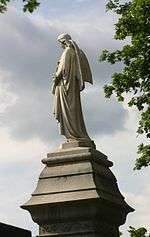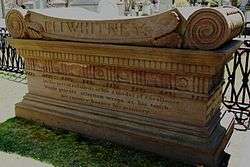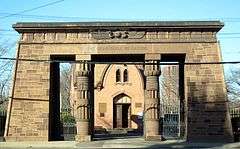Grove Street Cemetery
|
Grove Street Cemetery | |
|
The Egyptian Revival entry gateway | |
  | |
| Location | 200 Grove St., New Haven, Connecticut |
|---|---|
| Coordinates | 41°18′49″N 72°55′39″W / 41.31361°N 72.92750°WCoordinates: 41°18′49″N 72°55′39″W / 41.31361°N 72.92750°W |
| Area | 18 acres (7.3 ha) |
| Built | 1796 |
| Architect | Hezekiah Augur; Henry Austin |
| Architectural style | Egyptian Revival, Gothic Revival |
| NRHP Reference # | 97000830 |
| Significant dates | |
| Added to NRHP | August 8, 1997[1] |
| Designated NHL | February 16, 2000[2] |
Grove Street Cemetery or Grove Street Burial Ground in New Haven, Connecticut, is located adjacent to the Yale University campus. It was organized in 1796 as the New Haven Burying Ground and incorporated in October 1797 to replace the crowded burial ground on the New Haven Green. The first private, nonprofit cemetery in the world, it was one of the earliest burial grounds to have a planned layout, with plots permanently owned by individual families, a structured arrangement of ornamental plantings, and paved and named streets and avenues. This was "a real turning point... a whole redefinition of how people viewed death and dying", according to historian Peter Dobkin Hall, with novel ideas like permanent memorials and the sanctity of the deceased body.[3] In part for this reason, it was designated a National Historic Landmark in 2000.[4] Many notable Yale and New Haven luminaries are buried in the Grove Street Cemetery, including fourteen Yale presidents; nevertheless, it was not restricted to members of the upper class, and was open to all.[3]
History
Establishment (1796)
For the first 160 years of permanent settlement, New Haven residents buried their dead on the New Haven Green, the town's central open space and churchyard. In 1794–95, a yellow fever plague swept the town. The increased demand for burial space prompted James Hillhouse, a businessman and U.S. Senator, to invite other prominent families in the town to establish a dedicated burial ground on farmland bordering the town.[5] In 1796, thirty-two families purchased a tract just north of Grove Street, the tract was enclosed by a wooden fence, which was prone to rotting and needed to be replaced frequently. At first consisting of 6 acres (0.024 km2), the cemetery was quickly subscribed and thereafter expanded to nearly 18 acres (0.073 km2). Gravestones from the New Haven Green (but not the remains) were moved to the new cemetery for preservation in 1821 and are displayed against the walls of the cemetery.[3]
Gateway and fence construction (1845–49)
Completed in 1845, the entrance on Grove Street is a brownstone Egyptian Revival gateway, designed by New Haven architect Henry Austin, who is buried at the cemetery.[5] The style, popular in New England in that era, was chosen to reinforce the antiquity of the site.[6] The lintel of the gateway is inscribed "The Dead Shall Be Raised." The quotation is taken from 1 Corinthians 15.52: "For the trumpet will sound, and the dead shall be raised incorruptible, and we will be changed." Supposedly, Yale President Arthur Twining Hadley said of the inscription,"They certainly will be, if Yale needs the property."[7]
In 1848–49, the perimeter of the cemetery was surrounded on three sides by an 8-foot (2.4 m) stone wall.
Historic Landmarking
The cemetery was listed on the National Register of Historic Places in 1997.[1] It was designated a National Historic Landmark by the United States Secretary of the Interior in 2000, citing its history and the architectural significance of its gateway.[2][1][4]
Conflict over perimeter fence
In 2008, Yale announced plans to construct two new residential colleges to the immediate north of the cemetery. In 2009, university administrators and affiliates suggested to the cemetery Proprietors that an additional gate be constructed in the north section of the historic wall that surrounds the burial ground to permit pedestrians to walk through the cemetery from the main Yale campus to the planned new colleges. In addition, the Proprietors considered a proposal brought forward by one Proprietor that would replace portions of the stone sections of the wall bordering Prospect Street with iron fencing similar to that already running along the cemetery's southern border on Grove Street.[8] The proposal, withdrawn following a public meeting, included architectural and landscaping designs by Yale Architecture School Dean Robert A.M. Stern.[9]
Grove Street Cemetery is managed by Camco Cemetery Management.
Notable burials and memorials

- James Rowland Angell (1869–1949)—President of Yale University
- Kanichi Asakawa (1873–1948)—historian.
- Jehudi Ashmun (1794–1828)—religious leader, and social reformer, agent of the African Colonization Society
- Hezekiah Augur (1791–1858)—wood carver, sculptor and inventor.
- Henry Austin (1804–1891)—architect, designed the gate of the cemetery, Yale's College Library (which became Dwight Hall), and several mansions on Hillhouse Avenue.
- Delia Bacon (1811–1859)—originator of the proposition that Francis Bacon wrote the plays attributed to Shakespeare
- Leonard Bacon (1802–1881)—clergyman and abolitionist
- Charles Montague Bakewell (1867–1957)—politician
- Roger Sherman Baldwin (1793–1863)—Governor of Connecticut
- Simeon Baldwin (1761–1851)—Mayor of New Haven
- Simeon Eben Baldwin (1840–1927)—Governor of Connecticut
- Ida Barney (1886-1982) noted female American astronomer
- John Bassett (1652–1714)—captain of the trainband; deputy to the General Court (legislature) of Connecticut Colony
- Lyman Beecher (1775–1865)—abolitionist, father of Harriet Beecher Stowe and Henry Ward Beecher
- Nathan Beers (1763–1861)—paymaster to Connecticut troops in the American Revolution
- Hiram Bingham I (1789–1863)—Hawaiian missionary and clergyman.
- James Bishop (d. 1691)—was Secretary, Lieutenant Governor and Deputy Governor of New Haven Jurisdiction.
- Eli Whitney Blake (1795–1886)—manufacturer and inventor of the stone crusher. His brother, Philos, invented the corkscrew.
- William Whiting Boardman (1794–1871)—politician.
- Edward Gaylord Bourne (1860–1908)—historian and educator. Leader in the American Historical Association.
- Phineas Bradley (1745–1797)—soldier. Captain, commander of the artillery defending New Haven, July 5, 1779
- William H. Brewer (1828–1910)—scientist. Helped found the Yale Forestry School; co-founder of the list Agricultural Experiment Station with S. W. Johnson.

- James Brewster (1788–1866)— founder of Brewster & Co.; industrialist and railroad promoter.
- Kingman Brewster, Jr., (1919–1988)—President of Yale University
- William Bristol (1779–1836)—Mayor of New Haven, Connecticut.
- Walter Camp—football coach known as the "Father of American Football".
- Leverett Candee (1795–1863)—Industrialist. First practical use of Goodyear's vulcanization of rubber
- Arthur E. Case (1894–1946)—professor and author
- Jedediah Chapman (d. 1863)—Civil War Union Army Officer killed at the Battle of Gettysburg.
- Thomas Clap (1703–1767)—Rector & President of Yale College - buried in the City Burial Ground on the Green, stone later moved here
- David Daggett (1764–1851)—United States Senator, mayor of New Haven, Connecticut.
- Napthali Daggett (1727–1780)—clergyman, President pro tempore of Yale College.
- George Edward Day (1814–1905)—Bible revisor
- Jeremiah Day (1773–1868)—President of Yale University.
- Amos Doolittle (1754–1832)—silversmith, engraver of Revolutionary scenes. "The Revere of Connecticut."
- Timothy Dwight IV (1752–1817)—President of Yale University.
- Timothy Dwight V (1829–1916)—President of Yale University.
- Amos Beebe Eaton (1806–1877)—Civil War Union Army Brigadier General.

- Theophilus Eaton (1590–1657)—a founder of New Haven, first Governor of New Haven.
- Henry W. Edwards (1779–1847)—U.S. Representative, U.S. Senator, and Governor of Connecticut.
- Pierpont Edwards (1750–1826)—Delegate to the Continental Congress.
- Jeremiah Evarts (1781-1831)—scholar, writer and missionary executive. Editor of the ‘’Panoplist’’ and the ‘’Missionary Herald’’.
- Henry Farnham (1836–1917)—prominent New Haven merchant and philanthropist.
- George Park Fisher (1827–1902)—historian and theologian
- Andrew Hull Foote (1806–1863)—naval officer who ended the rum ration in the United States Navy.
- A. Bartlett Giamatti (1938–1989)—baseball commissioner, President of Yale University.
- Josiah Willard Gibbs, Sr. (1790–1861)—professor at Yale Divinity School who first spoke with the mutineers of the Amistad.
- Josiah Willard Gibbs, Jr. (1839–1903)—scientist, "Father of Thermodynamics"
- Chauncey Goodrich (1790–1860)—Yale professor of Homiletics and Pastoral Charge.
- Elizur Goodrich (1761–1849)—mayor of New Haven, Connecticut.
- Charles Goodyear (1800–1860)—inventor of vulcanized rubber.
- Alfred Whitney Griswold (1906–1963)—President of Yale University.
- Arthur Twining Hadley (1857–1930)—Dean of Yale Graduate School when women were first admitted. President of Yale University.
- Henry Baldwin Harrison (1821–1901)—Governor of Connecticut
- James Hillhouse (1754–1832)— real estate developer, politician, and treasurer of Yale. Namesake of Hillhouse Avenue in New Haven.
- J. Aspinwal Hodge (1861–1916)—Presbyterian minister in early New Haven, Connecticut.
- James Mason Hoppin (1820–1906)—professor of religion and art.
- Leverett Hubbard (1725-1795)—soldier, physician and apothecary.
- David Humphreys (1752–1818)—Aide de Camp to General George Washington
- Charles Roberts Ingersoll (1821–1903)—Governor of Connecticut
- Colin Macrae Ingersoll (1819–1903)—United States Representative from Connecticut.
- Ralph Isaacs Ingersoll (1789–1872)—United States Minister to Russia, mayor of New Haven, Connecticut.
- Eli Ives (1779–1861)—professor of Medicine
- Chauncey Jerome (1793–1868)—mayor of New Haven, clockmaker
- Nathaniel Jocelyn (1796–1881)—portrait painter and engraver.
- Samuel W. Johnson (1839–1909)—Yale professor, co-founder of the Agricultural Experiment Station Movement with William H. Brewer
- James Kingsley (1778–1852)—professor of Hebrew, Greek and Ecclesiastical History at Yale.
- John Gamble Kirkwood (1907–1959)—chemist.
- Charlton Miner Lewis (1866–1923)—Yale professor and author.
- Elias Loomis (1811–1889)—mathematician and astronomer.
- Daniel Lyman (1718–1788)—Surveyor, Deputy to the General Court, Court Referee, Justice of the Peace and caretaker of the State's public records.
- Samuel Mansfield (1717–1775)—first sheriff of New Haven
- Othniel Charles Marsh (1831–1899)—paleontologist.
- Henry Czar Merwin (1839–1863)—Civil War Union Army Officer killed at the Battle of Gettysburg
- Glenn Miller (Alton G. Miller) cenotaph -- (1904–1944)—Jazz bandleader, trombonist.
- Dr. Timothy Mix (1711–1779)—Colonial soldier who died on a British prison ship.
- Jedidiah Morse (1761–1826)—clergy, "Father of American Geography". Father of Samuel F. B. Morse.
- Theodore T. Munger (1830–1910)—clergyman.

- Hubert Anson Newton (1830–1896)—meteorologist and mathematician.
- George Henry Nettleton (1874–1959)—author.
- Denison Olmsted (1791–1859)—Professor of Medicine and Natural Philosophy at Yale. One of the first to see Halley's Comet in 1835.
- Lars Onsager (1903–1976)—Chemist. Nobel Laurate.
- Jaroslav Pelikan (1923–2006))— Scholar in the history of Christianity, Christian theology and medieval intellectual history.
- Timothy Pitkin (1766–1847)—politician, United States Representative from Connecticut.
- Noah Porter (1811–1892)—clergyman, President of Yale College
- Joel Root (1770–1847)—traveller, author.
- Charles Seymour (1885–1963)—President of Yale University
- Joseph Earl Sheffield (1793–1882)—merchant, founder of Sheffield Scientific School.
- Roger Sherman (1721–1793)— important founding father, the only person to have signed all four basic documents of American sovereignty, the Continental Association, the Declaration of Independence, the Articles of Confederation, and the United States Constitution. Today his grave is the center of this colonial city's Independence Day festivities.
- Benjamin Silliman (1779–1864)—pioneer in scientific education.
- Benjamin Silliman, Jr. (1816–1885)—Yale chemist and geologist. First suggested some practical uses for petroleum.
- Aaron Skinner (1800–1858)—civic figure and supervisor of improvements to Grove Street Cemetery
- Nathan Smith (1770–1835)—United States Senator from Connecticut.
- Ezra Stiles (1727–1795)—President of Yale University.
- Henry Randolph Storrs (1787–1837)—jurist.
- Titus Street (1786–1842)—businessman and civic figure

- Alfred Howe Terry (1827–1890)—Civil War Union Army Major General.
- Ithiel Town (1784-June 12, 1844)—architect and civil engineer. Inventor of the lattice truss bridge.
- Martha Townsend (1753–1797)—first interment in Grove Street Cemetery
- William Kneeland Townsend (1849–1907)—jurist
- Henry H. Townshend (1874–1953)—proprietor and historian of Grove Street Cemetery.
- Timothy Trowbridge (1631–1734)—merchant, soldier and politician.
- Alexander C. Twining (1801–1884)—inventor of first practical artificial ice system.
- Noah Webster (1758–1843)—lexicographer, dictionary publisher.
- Nathan Whiting—soldier, Colonel in the Seven Years' War.
- Eli Whitney (1765–1825)—inventor of the cotton gin.
- Theodore Winthrop (1828–1861)—Major, United States Army. First New Haven victim of the Civil War.
- Melancthon Taylor Woolsey (1717–1758)—colonel in the Colonial Army.
- Theodore Dwight Woolsey (1812–1889)—abolitionist, President of Yale.
- David Wooster (1711–1777)—Buried in Danbury, Connecticut but memorialized at Grove Street Cemetery.[10] Major General, 7th in rank below Washington. Killed in action.
- Mary Clabaugh Wright (1917–1970)—educator and historian, first woman to become a full professor at Yale.
See also
- List of National Historic Landmarks in Connecticut
- National Register of Historic Places listings in New Haven, Connecticut
References
- 1 2 3 National Park Service (2009-03-13). "National Register Information System". National Register of Historic Places. National Park Service.
- 1 2 "Grove Street Cemetery". National Historic Landmark summary listing. National Park Service. Retrieved 2007-10-03.
- 1 2 3 "Grant, Steve (26 December 2008). "History Disinterred". Hartford Courant. Archived from the original on 11 May 2015. Retrieved 10 May 2015.
- 1 2 Bruce Clouette (September 29, 1999), National Register of Historic Landmark Nomination: Grove Street Cemetery / New Haven City Burial Ground (pdf), National Park Service and Accompanying 32 photos, from 1997 and undated (32 KB)
- 1 2 Pinnell, Patrick (1999). The Campus Guide: Yale University. Princeton University Press. pp. 108–09.
- ↑ Giguere, Joy (2014). Characteristically American: Memorial Architecture, National Identity, and the Egyptian Revival. University of Tennessee Press. pp. 82–83. ISBN 9781621900771. Retrieved 10 May 2015.
- ↑ Taylor, Frances Grandy (23 September 2000). "Grove Street Cemetery At Yale Becomes U.S. Landmark Today". Hartford Courant. Retrieved 11 May 2015.
- ↑ Appell, Alan (7 October 2009). "Plot-holders Slam Cemetery Plan". New Haven Independent. Retrieved 11 May 2015.
- ↑ Appell, Alan (13 October 2009). "Cemetery Wall To Remain Undisturbed". New Haven Independent. Retrieved 11 May 2015.
- ↑ The Grove Street Bulletin, vol. 1, no. 4, 2005
Further reading
- History of the City Burial Ground in New Haven, together with the names of the owners of the lots therein. New Haven: J.H. Benham. 1863.
- Townshend, Henry H (1947). The Grove Street Cemetery. New Haven: The Whaples-Bullis Company. Retrieved 11 May 2015.
- Osterwies, Rollin G (1953). Three Cemeteries of New Haven, 1638-1938. New Haven: Yale University Press.
External links
| Wikimedia Commons has media related to Grove Street Cemetery. |
- Grove Street Cemetery home site
- New Haven Independent "Plot-holders Slam Cemetery Plan"
- New Haven Register "Architect pushes for changes at city cemetery"
- Peter Dobkin Hall, "Setting, Landscape, Architecture, and the Creation of Civic Space in the United States, 1790-1920"
- Findagrave
